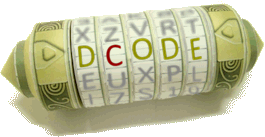Tool to separate values. Separating values allows delimiting the start and the end of each item with a character (commas, semi colons, etc.) for a clean separation.
Separation with Commas - dCode
Tag(s) : Data Processing
dCode is free and its tools are a valuable help in games, maths, geocaching, puzzles and problems to solve every day!
A suggestion ? a feedback ? a bug ? an idea ? Write to dCode!
Separation with Commas
Values Separator
Answers to Questions (FAQ)
What is a value separation? (Definition)
Value separation is a common operation in data processing. It ensures that the information contained in a file (often in text form) is correctly identified and interpreted.
In a CSV file, individual values are typically separated by commas, tabs, or other specific characters.
How to separate values?
dCode tries to catch all values and their separator automatically and proposes to reorganize them, either under the list form with the chosen delimiter, either under the table form (sortable), that can be exported to a spreadsheet like Excel.
Example: abc def ghi, jklm can be split at spaces/punctuation into abc|def|ghi|jklm with the separator/delimiter | (pipe)
What does CSV stands for?
CSV is the abbreviation of Comma-separated values, where values are delimited with a comma ,.
What does TSV stands for?
TSV is the abbreviation of Tabulation-separated values, where values are delimited with a tabulation character ↹.
How to choose a separator/delimiter?
The choice of separator is important: it must be distinct and not appear in the data fields themselves, to avoid confusion when reading.
There is no universal separator. Depending on the context, a user may encounter commas (,), semicolons (;), slashes (/), or other symbols.
Each line of the file corresponds to a record, and each value, separated by the chosen character, represents a column in the data table.
What are the most common separators?
The most common separators for delimiting values:
— Comma ,: most commonly used (CSV)
— Semicolon ;: used in Europe where the comma is used for decimals in numbers.
— Tab ⭾
— Space : simple, but not very visible
— Bar/Pipe |
— \n (line break)
— \0 (null)
Source code
dCode retains ownership of the "Separation with Commas" source code. Any algorithm for the "Separation with Commas" algorithm, applet or snippet or script (converter, solver, encryption / decryption, encoding / decoding, ciphering / deciphering, breaker, translator), or any "Separation with Commas" functions (calculate, convert, solve, decrypt / encrypt, decipher / cipher, decode / encode, translate) written in any informatic language (Python, Java, PHP, C#, Javascript, Matlab, etc.) or any database download or API access for "Separation with Commas" or any other element are not public (except explicit open source licence). Same with the download for offline use on PC, mobile, tablet, iPhone or Android app.
Reminder: dCode is an educational and teaching resource, accessible online for free and for everyone.
Cite dCode
The content of the page "Separation with Commas" and its results may be freely copied and reused, including for commercial purposes, provided that dCode.fr is cited as the source (Creative Commons CC-BY free distribution license).
Exporting the results is free and can be done simply by clicking on the export icons ⤓ (.csv or .txt format) or ⧉ (copy and paste).
To cite dCode.fr on another website, use the link:
In a scientific article or book, the recommended bibliographic citation is: Separation with Commas on dCode.fr [online website], retrieved on 2025-12-04,
